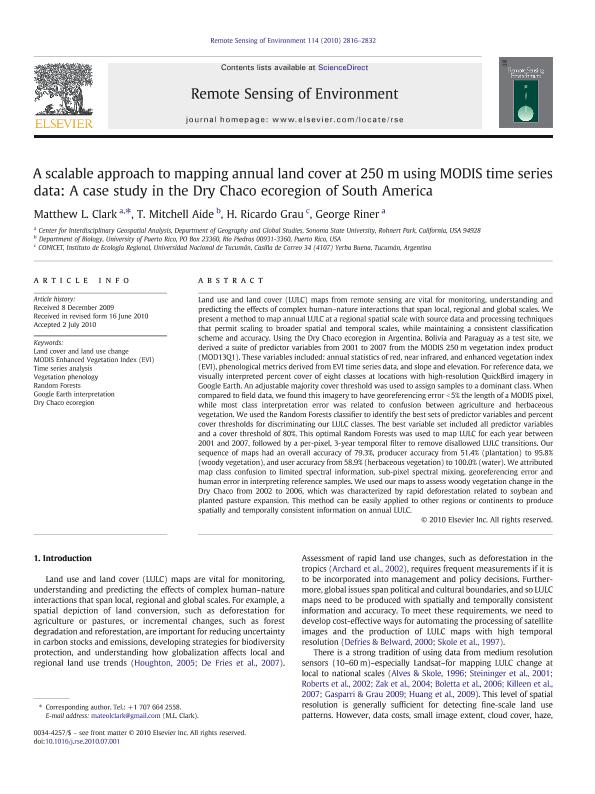Artículo
A scalable approach to mapping annual land cover at 250 m using MODIS time series data: A case study in the Dry Chaco ecoregion of South America
Fecha de publicación:
11/2010
Editorial:
Elsevier Science Inc
Revista:
Remote Sensing of Environment
ISSN:
0034-4257
Idioma:
Inglés
Tipo de recurso:
Artículo publicado
Clasificación temática:
Resumen
Land use and land cover (LULC) maps from remote sensing are vital for monitoring, understanding and predicting the effects of complex human-nature interactions that span local, regional and global scales. We present a method to map annual LULC at a regional spatial scale with source data and processing techniques that permit scaling to broader spatial and temporal scales, while maintaining a consistent classification scheme and accuracy. Using the Dry Chaco ecoregion in Argentina, Bolivia and Paraguay as a test site, we derived a suite of predictor variables from 2001 to 2007 from the MODIS 250. m vegetation index product (MOD13Q1). These variables included: annual statistics of red, near infrared, and enhanced vegetation index (EVI), phenological metrics derived from EVI time series data, and slope and elevation. For reference data, we visually interpreted percent cover of eight classes at locations with high-resolution QuickBird imagery in Google Earth. An adjustable majority cover threshold was used to assign samples to a dominant class. When compared to field data, we found this imagery to have georeferencing error <5% the length of a MODIS pixel, while most class interpretation error was related to confusion between agriculture and herbaceous vegetation. We used the Random Forests classifier to identify the best sets of predictor variables and percent cover thresholds for discriminating our LULC classes. The best variable set included all predictor variables and a cover threshold of 80%. This optimal Random Forests was used to map LULC for each year between 2001 and 2007, followed by a per-pixel, 3-year temporal filter to remove disallowed LULC transitions. Our sequence of maps had an overall accuracy of 79.3%, producer accuracy from 51.4% (plantation) to 95.8% (woody vegetation), and user accuracy from 58.9% (herbaceous vegetation) to 100.0% (water). We attributed map class confusion to limited spectral information, sub-pixel spectral mixing, georeferencing error and human error in interpreting reference samples. We used our maps to assess woody vegetation change in the Dry Chaco from 2002 to 2006, which was characterized by rapid deforestation related to soybean and planted pasture expansion. This method can be easily applied to other regions or continents to produce spatially and temporally consistent information on annual LULC.
Archivos asociados
Licencia
Identificadores
Colecciones
Articulos(CCT - NOA SUR)
Articulos de CTRO.CIENTIFICO TECNOL.CONICET - NOA SUR
Articulos de CTRO.CIENTIFICO TECNOL.CONICET - NOA SUR
Citación
Clark, Matthew L.; Aide, T. Mitchell; Grau, Hector Ricardo; Riner, George; A scalable approach to mapping annual land cover at 250 m using MODIS time series data: A case study in the Dry Chaco ecoregion of South America; Elsevier Science Inc; Remote Sensing of Environment; 114; 11; 11-2010; 2816-2832
Compartir
Altmétricas




